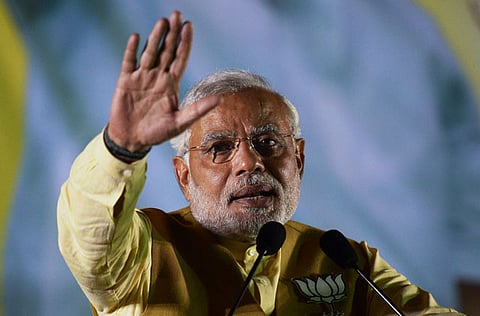Indian prime minister's visit to renew UAE-India bonds
Indian community reminisces golden years and hope visit will refresh deep ties

Dubai: The Indian community in the UAE expects the visit of Indian Prime Minister Narendra Modi to strengthen the age old historical, social, cultural ties between the two countries.
From as early as the 13th century AD, the seaports in the Gulf from Aden to Dubai were popular trade spots for seafaring businessman from the Indian states of Sindh and Saurashtra. They travelled and lived at these ports trading in textiles, spices, rice, pearls and precious stones and livestock among other things.
Arab dhows got the teak wood from India and the pearl divers sold pearls to Indian jewellers in exchange for food, textiles and other goods before cash transactions became the normal practice.
Veteran spokesperson of the Indian community in Dubai, Bharat Bhai Shah who came to Dubai in the early seventies said: “Those days all traders of the coastal areas of Gujarat — Saurashtra, Porbandar and other places, travelled to the Gulf countries. Aden in Yemen and Dubai were popular. It was easier for traders from northern India to pick up Arabic as many Persian words are included in the colloquial Hindi language. Even Ibn Battuta, the ancient Arab traveller has mentioned meeting Indian traders during his travels. I can see these old ties being renewed after three decades of drought,” said Shah who came to Aden as early as 1948 as an Indian houseboy and worked his way up to become a successful Indian businessmen in Saudi Arabia and finally in the UAE.
Ram Buxani, the president of ITL group credits the Thattai Bhatias of Sindh Province in undivided India for having further cemented trade and culture ties with the UAE. “Two hundred years ago, the Thattai Bhatias came to Dubai. When Port Lingah in Iran began levying taxes, they were invited to here and began trading in food grains, textiles, spices and other provisions. They had the money and the connections to buy pearls from divers here and sell it in Mumbai and became an important link in the pearl trade. When the pearl divers went to sea, they would be away for long spans of two to three months especially during the summers. It was in those times that the Bhatia community stepped into to provide food and other provisions for the families left behind. There was a sense of mutual trust that the Bhatias shared with the locals.”
Buxani added: “In fact, the present Krishna Temple at Bastakiya is 150 years old built in those times and the fact that it is barely 20 yards from the mosque bears testimony to the camaraderie that the two communities shared. Hindi was spoken fluently by the Emiratis and Indian Rupee was the currency of exchange before 1971. Most rich Emirati businessmen had apartments on Marine Drive in Mumbai and sent their children for higher education to India besides trusting Indian hospitals for their health care needs.”
He also recalled: “When I came here in the early seventies, Diwali used to be a holiday with most shops and trade establishments belonging to Indian businessmen being shut for the festival.”
Buxani feels the cultural integration between the two countries is already complete. “What we need is to renew those ties which will happen with Modi’s visit.”
Businessman B.R. Shetty seconds that. “We can expect strong renewal of bilateral trade relations between India and the UAE and one can expect big investments from the UAE in the field of infrastructure, health, education, drinking water among other things. India is a strong ally for the UAE and a great source of excellent human resources. One can only expect more positive developments on the trade and business front as the cultural and historical ties between the two countries need no introduction.”
Adeeb Ahmad, CEO of Lulu International Exchange also expressed his optimism about a boost in Indo-UAE trade relations. “I believe this visit will help improve cultural and trade ties between the two economies and build stronger relationships as well. UAE is India’s third largest trading partner, valued at around $60 billion (Dh220 billion), after China and US. I am confident this visit will bolster investments on both sides and increase trade as well. It will also be a great opportunity for the Prime Minister to invite regional companies to take part in the ‘Make in India’ initiative, which is one of the Indian government’s flagship programmes.”
Sign up for the Daily Briefing
Get the latest news and updates straight to your inbox



